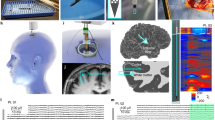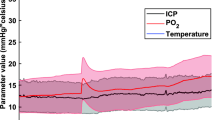Abstract
Single-neuronal studies remain the gold standard for studying brain function. Here we describe a protocol for studying task-related single-neuronal activity in human subjects during neurosurgical procedures involving microelectrode recordings. This protocol has two phases: a preoperative phase and an intraoperative phase. During the preoperative phase, we discuss informed consent, equipment setup and behavioral testing. During the intraoperative phase, we discuss the procedure for microelectrode recordings. Because patients are often awake during these procedures, this protocol can be performed in conjunction with behavioral tasks for studying a variety of cognitive functions. We describe the protocol in detail and provide two examples of expected results. In addition, we discuss the potential difficulties and pitfalls related to intraoperative studies. This protocol takes ∼1.5 h to complete.
This is a preview of subscription content, access via your institution
Access options
Subscribe to this journal
Receive 12 print issues and online access
$259.00 per year
only $21.58 per issue
Buy this article
- Purchase on Springer Link
- Instant access to full article PDF
Prices may be subject to local taxes which are calculated during checkout







Similar content being viewed by others
References
Hyde, I. A microelectrode and unicellular stimulation of single cells. Biol. Bull. 71, 130–133 (1921).
Hodgkin, A.L. & Huxley, A.F. Action potentials recorded from inside a nerve fibre. Nature 144, 710–711 (1939).
Eccles, J.C. & O'Connor, W.J. Responses which nerve impulses evoke in mammalian striated muscles. J. Physiol. 97, 44–102 (1939).
Eccles, J.C. & Kuffler, S.W. The endplate potential during and after the muscle spike potential. J. Neurophysiol. 4, 486–506 (1941).
Hubel, D. Tungsten microelectrode for recording from single units. Science 125, 549–550 (1957).
Albe-Fessard, D., Dumont-TYC, S. & Jankowska, E. Somatotopic and associative neuron activities measured at the level of the primary somatic surface. J. Physiol. 53, 243–244 (1961).
Guiot, G., Hardy, J. & Albe-Fessard, D. Precise delimitation of the subcortical structures and identification of thalamic nuclei in man by stereotactic electrophysiology. Neurochirurgia 5, 1–18 (1962).
Gaze, R.M. et al. Microelectrode recordings from the human thalamus. Brain 87, 691–706 (1964).
Hardy, J. The development of the stereotaxic method in neurosurgery. Union Med. Can. 90, 969–971 (1961).
Hamani, C. et al. Correspondence of microelectrode mapping with magnetic resonance imaging for subthalamic nucleus procedures. Surg. Neurol. 63, 249–253; discussion 253 (2005).
Starr, P.A. et al. Implantation of deep brain stimulators into the subthalamic nucleus: technical approach and magnetic resonance imaging-verified lead locations. J. Neurosurg. 97, 370–387 (2002).
Bakay, R.A.E. Movement Disorder Surgery. The Essentials (Thieme Medical Publishers, 2008).
Hassler, R., Mundinger, F. & Riechert, T . Pathophysiology of tremor at rest derived from the correlation of anatomical and clinical data. Confin. Neurol. 32, 79–87 (1970).
Wichmann, T. & DeLong, M.R. Pathophysiology of Parkinson's disease: the MPTP primate model of the human disorder. Ann. N Y Acad. Sci. 991, 199–213 (2003).
Christine, C.W., Langston, J.W., Turner, R.S. & Starr, P.A. The neurophysiology and effect of deep brain stimulation in a patient with l-methyl-4-phenyl-l,2,3,6-tetrahydropyridine-induced parkinsonism. J. Neurosurg. 110, 234–238 (2009).
Amirnovin, R., Williams, Z.M., Cosgrove, G.R. & Eskandar, E.N. Visually guided movements suppress subthalamic oscillations in Parkinson's disease patients. J. Neurosci. 24, 11302–11306 (2004).
Zaghloul, K.A. et al. Human substantia nigra neurons encode unexpected financial rewards. Science 323, 1496–1499 (2009).
Sheth, S.A. et al. Human dorsal anterior cingulate cortex neurons mediate ongoing behavioural adaptation. Nature 488, 218–221 (2012).
Patel, S.R. et al. Single-neuron responses in the human nucleus accumbens during a financial decision-making task. J. Neurosci. 32, 7311–7315 (2012).
Mian, M.K. et al. Encoding of rules by neurons in the human dorsolateral prefrontal cortex. Cereb. Cortex http://dx.doi.org/10.1093/cercor/bhs361 (21 November 2012).
Starr, P.A., Barbaro, N.M. & Larson, P.S. Neurosurgical Operative Atlas. Functional Neurosurgery (Thieme Medical Publishers, 2008).
Asaad, W.F. & Eskandar, E.A. A flexible software tool for temporally-precise behavioral control in MATLAB. J. Neurosci. Methods 174, 245–258 (2008).
Asaad, W.F. & Eskandar, E.N. Achieving behavioral control with millisecond resolution in a high-level programming environment. J. Neurosci. Methods 173, 235–240 (2008).
Williams, Z.M. & Eskandar, E.N. Human anterior cingulate neurons and the integration of monetary reward with motor responses. Nat. Neurosci. 7, 1370–1375 (2004).
Weise, L., Eibach, S., Seifert, V. & Setzer, M. Intraoperative 3D fluoroscopy in stereotactic surgery. Acta Neurochir. 154, 815–821 (2012).
Kramer, D.R. et al. Best surgical practices: a stepwise approach to the University of Pennsylvania deep brain stimulation protocol. Neurosurg. Focus 29, E3 (2010).
Xie, K., Wang, S., Aziz, T.Z., Stein, J.F. & Liu, X. The physiologically modulated electrode potentials at the depth electrode-brain interface in humans. Neurosci. Lett. 402, 238–243 (2006).
Maciver, M.B., Bronte-Stewart, H.M., Henderson, J.M., Jaffe, R.A. & Brock-Utne, J.G. Human subthalamic neuron spiking exhibits subtle responses to sedatives. Anesthesiology 115, 254–264 (2011).
Acknowledgements
This work was supported by grants from the US National Institutes of Health (NIH) (National Institute on Drug Abuse (NIDA) no.R01DA026297). E.N.E. was supported by National Eye Institute (NEI) grant no. NEI 1R01EY017658-01A1, the National Institute of Mental Health (NIMH) Conte Award no. MH086400, the Klingenstein Foundation, the Howard Hughes Medical Institute and the Dana Foundation. S.R.P. was supported by the Sackler Programme in Psychobiology. S.A.S. was supported by National Institute of Neurological Disorders and Stroke (NINDS) grant no. R25 NS065743. We thank K. Finnis for providing the 3D reconstructions.
Author information
Authors and Affiliations
Contributions
S.R.P., S.A.S., C.M.-R., M.K.M., W.F.A., J.L.G., C.-S.K., J.T.G., Z.M.W. and E.N.E. designed, conducted or analyzed the data. D.D.D., A.W.F., B.D.G., Z.M.W. and E.N.E. evaluated the patients and provided clinical care. S.R.P. and S.A.S. wrote the manuscript. All the authors edited the manuscript.
Corresponding author
Ethics declarations
Competing interests
The authors declare no competing financial interests.
Rights and permissions
About this article
Cite this article
Patel, S., Sheth, S., Martinez-Rubio, C. et al. Studying task-related activity of individual neurons in the human brain. Nat Protoc 8, 949–957 (2013). https://doi.org/10.1038/nprot.2013.050
Published:
Issue Date:
DOI: https://doi.org/10.1038/nprot.2013.050
This article is cited by
-
Single-neuronal elements of speech production in humans
Nature (2024)
-
Modified Neuropixels probes for recording human neurophysiology in the operating room
Nature Protocols (2023)
-
Large-scale neural recordings with single neuron resolution using Neuropixels probes in human cortex
Nature Neuroscience (2022)
-
Single-neuronal predictions of others’ beliefs in humans
Nature (2021)
-
Dorsolateral prefrontal neurons mediate subjective decisions and their variation in humans
Nature Neuroscience (2019)
Comments
By submitting a comment you agree to abide by our Terms and Community Guidelines. If you find something abusive or that does not comply with our terms or guidelines please flag it as inappropriate.



